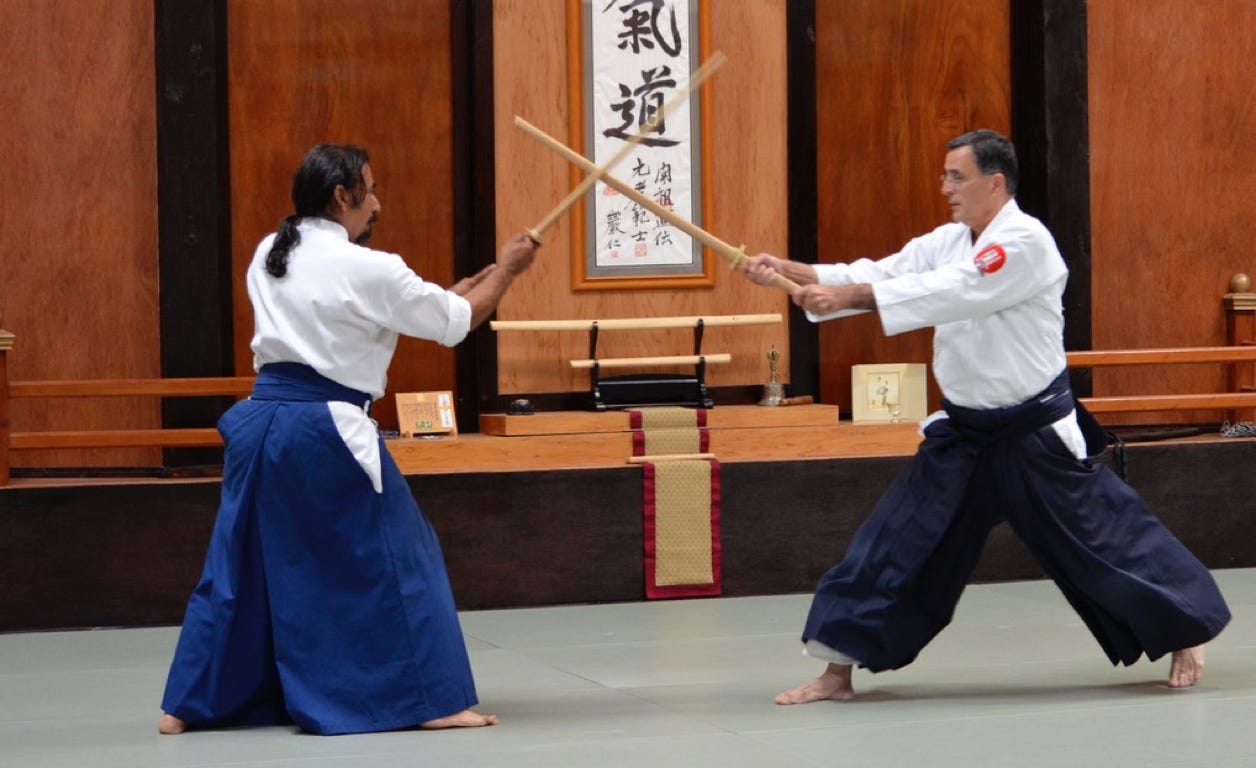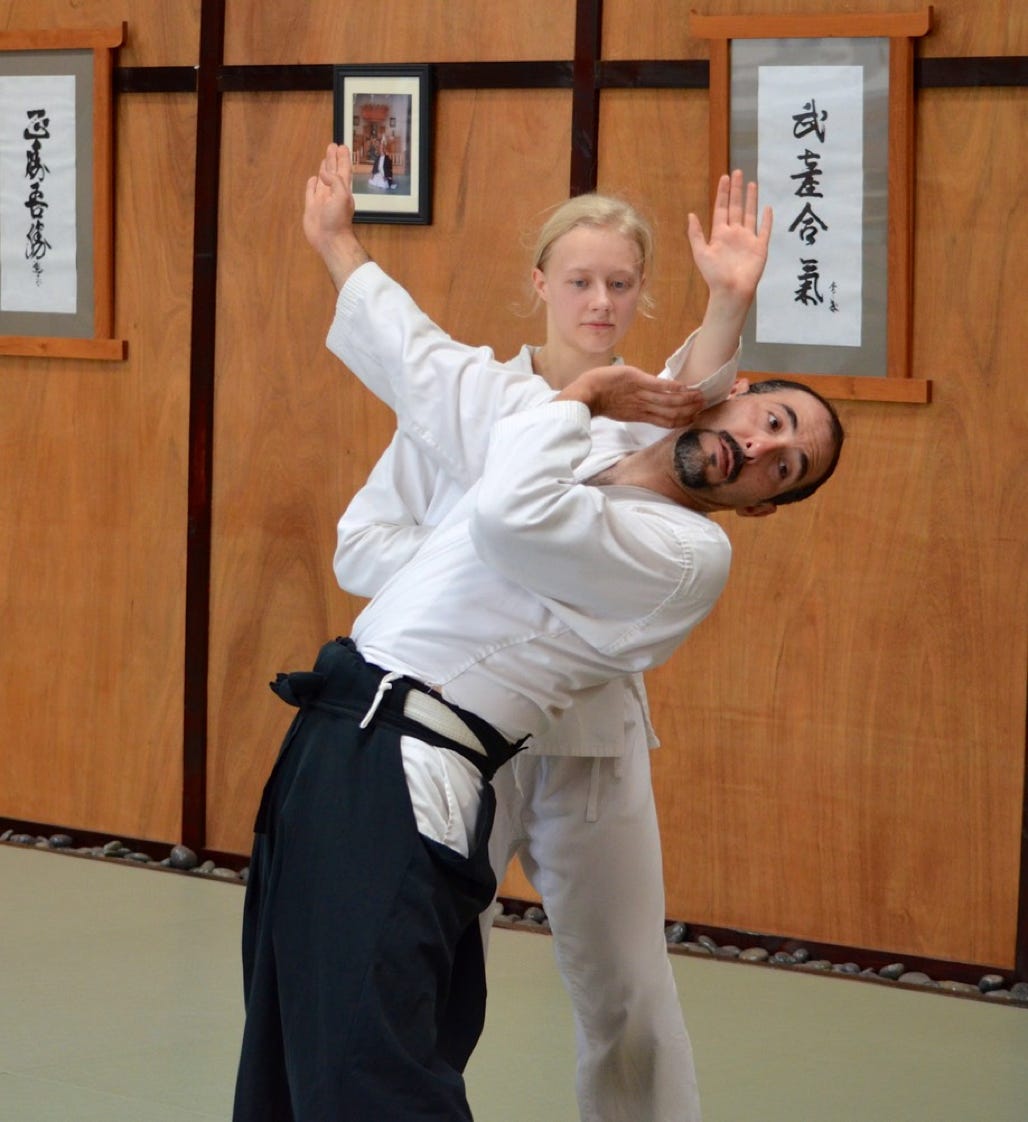
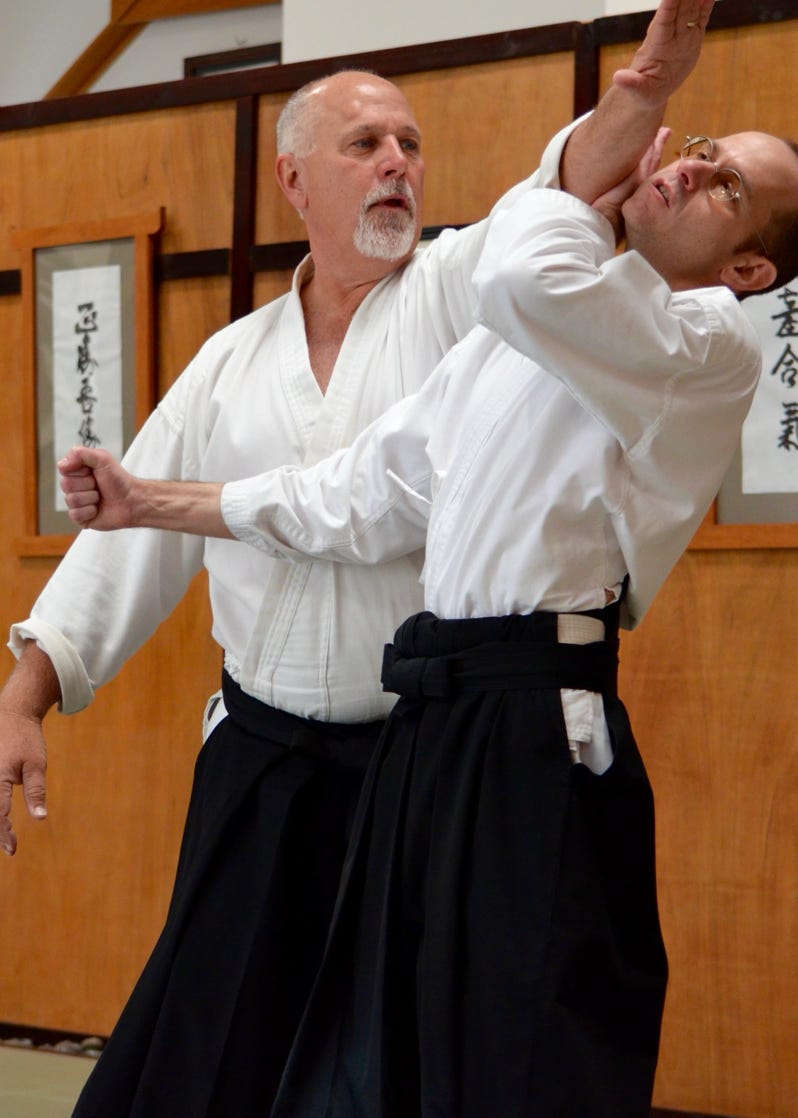
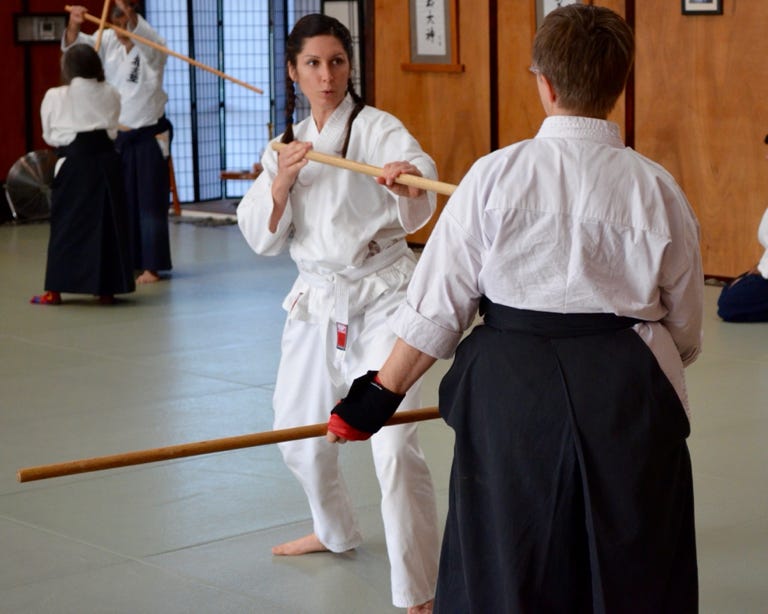
What to Expect in Class:
We begin with warm-ups, breathing exercises and stretching, all expressing Aikido principles, followed by practice in safely rolling on the mat. Techniques are then practiced with partners and there is usually included some solo or partner weapons work. The intensity of the class ranges from a slow, contemplative study to a challenging cardiovascular and mental workout. Class ends with cool-down stretching and breath-work.
What to Expect When You Start:
Please come in 15 minutes before Basics/Beginners class time.
You will be greeted by one of our senior members, who will introduce you to the Dojo, changing rooms etc. You will be introduced to the class instructor and your fellow students and to basic etiquette as used in our school.
During this introduction, feel free to let us know your goals in practicing Aikido, as well as any concerns you may have.
Once class starts, you will be introduced to some simple warmups and stretches. You will then be helped to safely roll onto your back, from and back to a sitting or kneeling position - a basic training in safety which has the added benefit of being a good self-massage! Please note that you do not have to do anything that feels uncomfortable or physically unsafe - and if you don’t have the timing quite right, that’s fine!
You may be placed with a dedicated senior student for a part of that class, practicing one-on-one and slowly on a specific technique. In time you will be introduced to forward and back rolls. When Sensei (the teacher) feels the timing is right (within the first few days of your practice), you will be well-prepared to join the whole class as a regular student, steadily growing in skill, and at a pace which is challenging, yet safe, for you.
Equipment Needed:
Beginning students can wear comfortable workout clothing, preferably workout pants and a t-shirt. Please avoid wearing jewelry, strong perfumes or cologne. (Valuables can be placed in the cubbies near the training mat.)
As soon as possible, obtain a white dogi (uniform) — inquire for recommended sites. Soon after, we suggest you obtain a bokken (wooden sword) and jo (wooden staff). A tanto (practice knife) is also recommended. Within two months of training, you are welcome to wear a black or blue hakama (divided outerwear pant, as in the pictures above).
The Purpose of Aikido Training:
Aikido teaches the mind to evolve beyond both aggressiveness and timidity, so as to peacefully resolve conflict without capitulation and to effectively control attacks and other dangers without excessive force: in short, to have a dignified and humane response to any life situation.
Aikido is neither a sport for winning matches, nor is it merely a collection of fighting techniques: rather it is a way of practicing fearless graciousness and balance: we use that dynamic balance as the basis, not only of self-protection, but of all our life-skills.
In keeping with its spirit of reconciliation, Aikido is a non-competitive martial art. But competition is also eschewed for the sake of safety, because Aikido deals directly with combative situations where there are no rules. Aikido is not a sport, with its rigid rules, winners and losers. The goal of Aikido is that everyone “wins.”.
The beauty and grace of Aikido has lead many observers to refer to it as “moving meditation,” “yoga in movement,” and as “the art of peace.” Its techniques exhibit harmonious and graceful movement, grounded in a strong center and presence. Please do not be beguiled, as many are, into thinking that graceful and effortless looking Aikido is a mere dance with no practical application. Where severity and finality in self-defense is required, Aikido is there!
As mentioned above, this practice is intended to be integrated into our everyday lives as a way of natural being, unfettered by artificial and habitual limitations. The goal of this class is to foster mental confidence, physical grace and generosity of spirit, and to learn Aiki (being in harmony with one’s situation), via technical training. Through this training we gain the capacity, not only to protect ourselves, but to protect and nurture the world - in whatever way is most natural.
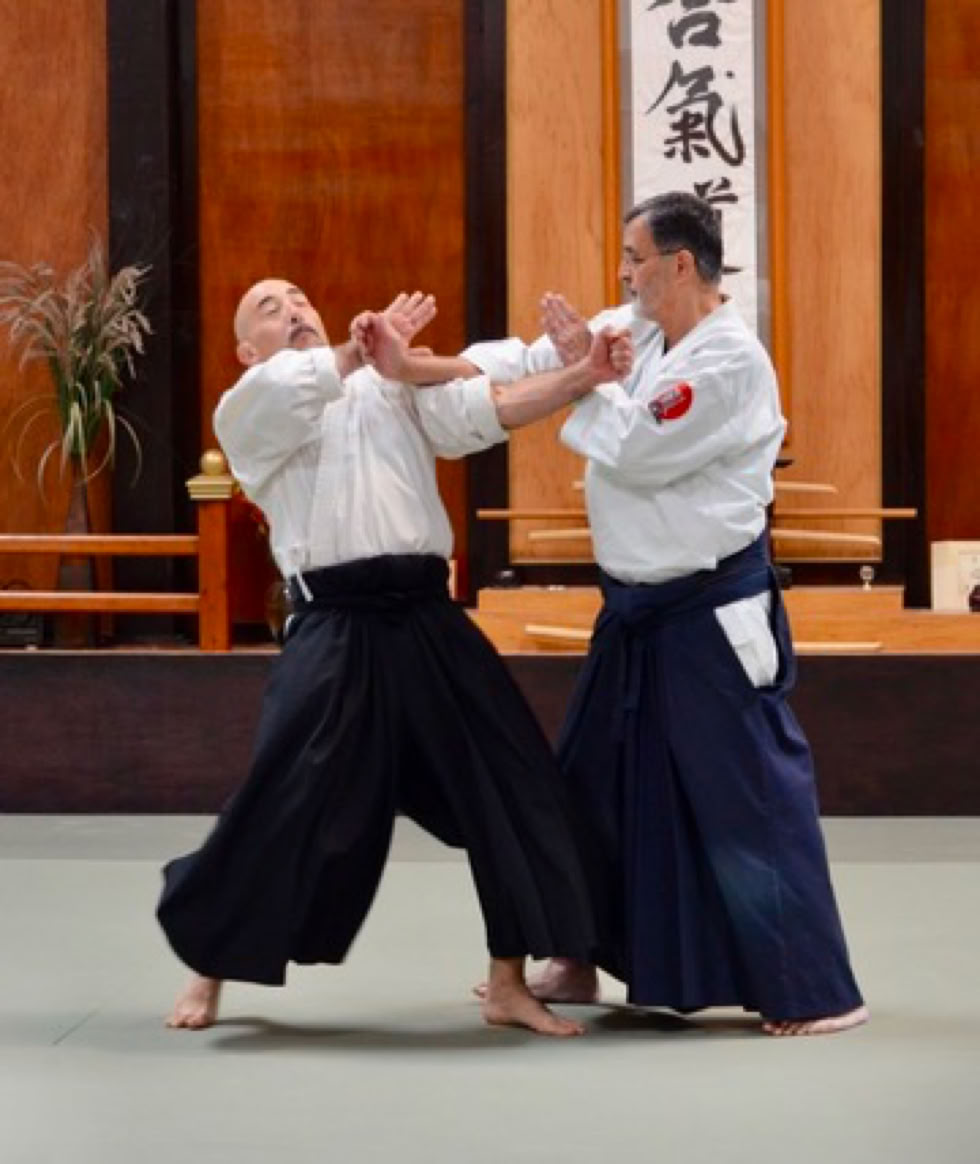
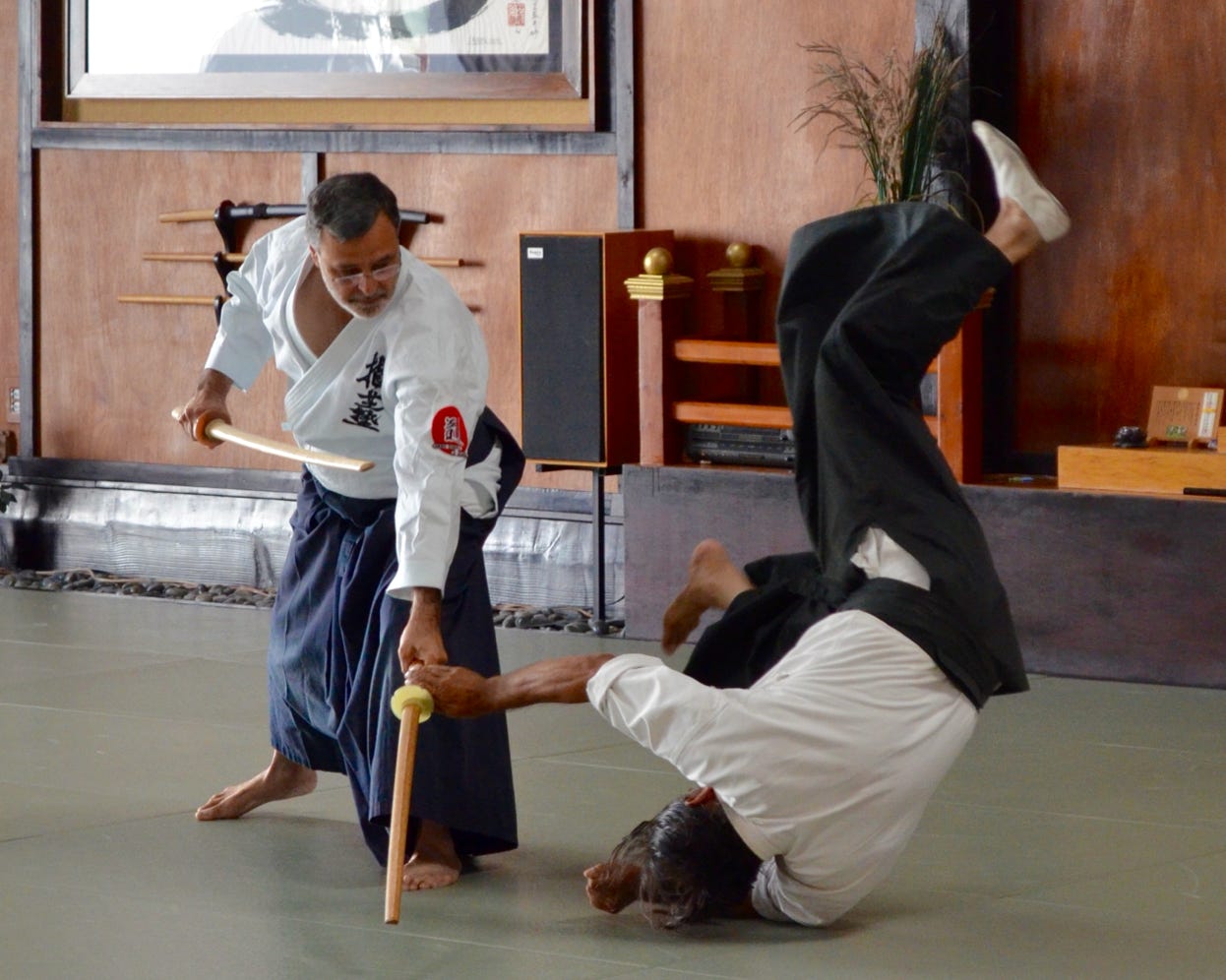
Self-Protection Aspects: Flow, Don’t just “fight”
No amount of skill in technical fighting "moves" are of any use, if one is in the grip of emotions like anger or fear. Under their control, we have only three options: Fight, Flee or (worse) Freeze. What If our emotions, rather than controlling us, were under our control? Then they could fulfill their best function: of being highly sophisticated perceptions of the reality we find ourselves in. That
would allow us the fourth, most human option: Flow.
“To flow with” and “to be in balance with” are two of the meanings of the Japanese word Aiki.
This is why traditional martial arts training concentrates on inner transformation: a change in attitude that includes the courage of good character. In Aikido confidence comes from knowing one can completely neutralize an attack without excessive force, while maintaining a peaceful and therefore effective mind. The promise of countless great practitioners of Budo is that even if one is much smaller, slower, older or weaker than a dangerous adversary, one can yet be effective - and survive, or even thrive! Of course, no martial art can guarantee survival, but Aikido practitioners find that it is safer to escape from holds and strikes, by using throws, strikes, sweeps and pins, working in balance with the attacker’s intention and energy, rather than by attempting to fight against them using maximum physical force.
We also practice a significant amount of hand-held weapons training that, by dramatically intensifying the experience of the inner principles of Aikido, can be valuable for staying relaxed and skillful in self-defense or in any other stressful situation.
Besides, it’s all a lot of fun!
Benefits of Aikido:
Training in Aikido delivers all the benefits of traditional martial arts: good physical conditioning, flexibility and skillful mastery. It generates relaxed confidence, honesty, energy, tenacity, open mindedness, politeness, consideration for others, taking personal responsibility — all qualities of character to be carried into one's daily life. Moreover you can expect improved skill in sports and the performing arts and an increased ability to relax, as much as possible, into the stressful situations of daily life. A health-giving aspect is breath-work, an integral aspect of Aikido practice. Our breath is said to be that which connects the spirit and the body, and through practice we learn how to release and free the breath to find its natural rhythm under any circumstance.
Aikido, in particular, engenders an attitude of cooperation and consideration, beyond the usual camaraderie of training with others. Aikido is ethically based on protecting from harm - not just the one attacked, but the attacker as well. As a result children and adults learn to respond to life-situations (including those of self-defense) with compassion, decisiveness and appropriate force. We aim to better society one person at a time, striving every day to be better citizens: whether as workers, spouses, parents, children, siblings or in any other social or individual function.
Buki (practice with weapons)
Aikido has its technical roots in the subtle grappling arts of Aiki-Jujitsu together with the elegant forms of combat sword (Kenjitsu) and combat Staff, ( Jodo). We study traditional Japanese solo sword and staff forms, Aikido weapons disarming techniques and interactive weapons work such as those practiced by the samurai warriors of the past. Our test requirements include extensive work with Kumitachi (sword-on-sword), Kumijo (staff-on-staff) and weapons-disarming. We also practice other combinations of weapons, such as staff or knife with sword, as well as two-sword techniques and multiple attacks with weapons. Throughout our goal is to embody basic principles of Aiki, or unity. At Redlands Aikikai we practice weapons exclusively during our Aikido Weapons class, and most of our regular classes include weapons work. We also do one-day weapons seminars, and weapons practice is usually featured as an aspect of all our seminars.
